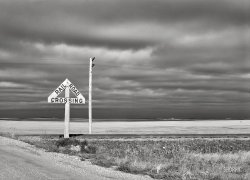
MAY CONTAIN NUTS

Search Shorpy
SHORPY ART

Framed or unframed, desk size to sofa size, printed by us in Arizona and Alabama since 2007. Explore now.
Join and Share
Ad-Free Shorpy
Shorpy is funded by you. Patreon contributors get an ad-free experience.
Learn more.

Recent comments
- Exclusive pump
- Details, Details
- What's that building to the left of the tower?
- Coal Barges
- Bromo-Seltzer
- Inner harbor
- The Basin
- What a headache!
- Giant stepladder?
- Baldwin 62303
- Baldwin VO-1000
- Cold
- No expense spared
- Tough Guys
- Lost in Toyland
- And without gloves
- If I were a blindfolded time traveler
- Smoke Consumer Also Cooks
- Oh that stove!
- Possibly still there?
- What?!?
- $100 Reward
- Freeze Frame
- Texas Flyer wanted
- Just a Year Too Soon
- WWII -- Replacing men with women at the railroad crossing.
- Yes, Icing
- You kids drive me nuts!
- NOT An Easy Job
- I wonder
Member Photos
The Shorpy
Print Emporium
Print Emporium
Search Shorpy
Search results -- 30 results per page
- Ghost Child: 1936
- ... Oklahoma City shacktown. August 1936. View full size. Farm Security Administration photograph by Dorothea Lange.
children solten laugh ... Posted by Dave - 05/04/2018 - 11:30am -
![Ghost Child: 1936 Child living in Oklahoma City shacktown. August 1936. View full size. Farm Security Administration photograph by Dorothea Lange.
children solten laughso young and already such a serious view of children solten laugh
Re: children solten laugh"solten"??
Ghost ChildShe looks like the actress that played Scout in the movie TO KILL A MOCKINGBIRD.
It was Mary Badham.
:-)
AndIt was Mary Badham.
:-)
And yeah she does...
I think "solten" is GermanI think "solten" is German for "[they] should", so presumably "such a serious view of [life], children should laugh".
I assumed the child was a boy
SoltenGood insight. I think German would be sollten. Solten might be Yiddish.
CHILDREN SOLTEN LAUGHBLACK EYE, NO DOUBT :(
ShacktownThis area used to be the edge of town. It is now exclusive homes, shopping and office buildings.
Ghost ChildSo young and you can just tell that she has been through so much.
That stare says a lot.
"Family of Man"This portrait is in the "Family of Man" photo book. I've had this book for 40+ years. A lot of photos from the the Depression, including the next photo of this set. One of the books that got me interested in photography.
Not One More KidI see so much pain in this picture and so little hope; so tragic to think that this kid, or any kid for that matter, lived through all the unspeakable things so plainly seen in this photo. So many layers of scarring if you look close enough.
What an incredibly powerful photograph, as are many of Dorothea Lange's. Saw them up close in NYC's MoMA last weekend, and I am very glad I did.
If I have any wish for this world it is that we get connected enough to each other that it will be impossible for a kid to be this isolated in poverty and despair ever again.
(The Gallery, Dorothea Lange, Kids, OKC)](https://www.shorpy.com/files/images/8b38490u.thumbnail.jpg)
- The Big Easy: 1935
- ... New Orleans." 35mm nitrate negative by Ben Shahn for the Farm Security Administration. View full size.
Lean Times Sort of a Jack ... Posted by Dave - 09/13/2011 - 4:40pm -
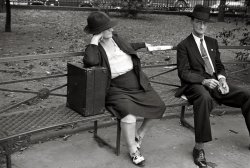
- The 'Super Market': 1940
- ... quote marks. 35mm nitrate negative by Jack Delano for the Farm Security Administration. View full size.
Shopping for nostalgia ... Posted by Dave - 05/02/2022 - 11:01am -
![The 'Super Market': 1940 May 1940. "The 'super market' in Durham, North Carolina." Back when self-service groceries were enough of a novelty that photographers put the name for them in quote marks. 35mm nitrate negative by Jack Delano for the Farm Security Administration. View full size.
Shopping for nostalgiaAleHouseMug - A coffee roaster in Burbank has bought the rights to Bokar Coffee and has attempted to recreate the taste.
JennyPennifer There are multiple recipes for Spanish Bar Cake, if you bake. Or you can order one directly from the Jane Parker Bakery. They supplied the cakes to A&P originally, and claim to be using the original recipe now. The only downside is that they cost much more than what you paid at A&P.
Y'all are on your own for those home killed fryers.
That's the Post Office in the background. The current location of the old A&P is now a parking deck.
I sometimes park hereAs J. W. Wright pointed out, the A&P at the corner of Rigsbee & E Chapel Hill is now a parking deck. The Post Office across the street is unchanged, and seems to be in good shape.
There were about a dozen A&P stores in Durham in 1940, but most were the old-fashioned small stores, not the new-fangled super markets.
Long gone nowA&P Supermarkets dominated Durham all the way into the 70's. Here is a little history of this one on Rigsbee:
https://www.opendurham.org/buildings/rigsbee-avenue-super-market
Tasty TimesBecause who doesn't remember fondly when advertising Fryers as being "Home Killed" wasn't seen as a major selling point?
Your meter is runningEven the cabbie couldn't pass up the home killed chickens! Love the brush lettering. Reminds me of my old Speedball text book. We used to go shopping with dad at the A&P when we lived in Cockeysville, MD in the early 60's. I can still smell the coffee when you passed the grinder! They had an A&P in Mathews, VA when my folks moved there in the mid-70's.
Three BlendsHow I miss Bokar Coffee.
Back when ...... you could park your bicycle on a sidewalk without a lock.
I love this photoAnd it looks for all the world like the building and market that was used in the movie "Driving Miss Daisy." I remember when most "supermarkets" looked like this - I was born in 1945 and I remember as early as 1948 going with my mother to the local Kroger store that was in a building smaller than this one. Great photo. More, more.
I remember it wellThe A&P will forever be to me one item: Spanish Bar Cake. Every now and then Mama would buy one -- dark, spicy, applesaucy cake studded with raisins and nuts and coated with a generous layer of cream cheese icing featuring a fork-tine design that resembled corduroy. We couldn't wait for a thick hunk of that cake to land in our hands. To smell it was almost as good as to taste it.
Much obliged... to archfan for the info. I am aware of the many recipes for "original" Spanish Bar Cake and have a few stored in my recipe file. A friend made one for me some years ago and the result was, shall we say, close but no cigar. Since we know that certain childhood memories are far more likely to be emotional than factual, it's possible that nothing not bought at the A&P, rung up with one of those gloriously chunk-kachunky cash registers and coming from my mother's hand will do it for me. But I do plan to make the recipe that I think would most approximate what I remember, and if it truly does the job, I will report back. As for Jane Parker, all I can say is that she's got her nerve charging $36 for that. Nope!
A Night to Rememberby Walter Lord was on the paperback carousel at the A&P on 11th Street in Waco, Texas, in 1955 -- my first exposure to the Titanic tragedy. I mentioned it to my mother and she told me she was 10 when it sank. She added it to her tab before checking out, and I was hooked on Titanic from that point on.
8 O'ClockMy memory goes back to when I was about 3, and my parents would take my maternal grandmother (she didn't drive) to the A&P in tiny New Freedom, Pa. I would gravitate quickly to the 8 O'Clock grinder area just to smell the coffee being ground.
Here I am now, at 74, typing out this memory, and I'm sipping a mug of 8 O'Clock Original. Just think of me as "hooked for life."
Not so fast, Broadway!Gimme a minute to write down that phone number.
Coffee"How I miss Bokar Coffee"
There was also a stronger brew -- Rokah.
Check my math.
[Your math does not add up! - Dave]
Super A&P MarketThe big sign on the roof looks like steel-embossed and porcelain enameled panels. They last forever. An unmolested version is a very sought after commodity today.
Broadway Taxi Broadway Taxi changed its name to Broadway Yellow Cab in the 1970s, and was still operating in the mid 1980s -- its depot was on Hunt Street.
(The Gallery, Jack Delano, Stores & Markets)](https://www.shorpy.com/files/images/SHORPY-8a33841a.thumbnail.jpg)
- Family Portrait: 1936
- ... Hale County, Alabama. Photograph by Walker Evans for the Farm Security Administration. View full size.
Lewis Hine What a ... Posted by Dave - 09/08/2011 - 8:52pm -
![Family Portrait: 1936 Summer of 1936. William Edward "Bud" Fields, wife Lily Rogers Fields and infant daughter Lilian at their sharecropper cabin in Hale County, Alabama. Photograph by Walker Evans for the Farm Security Administration. View full size.
Lewis HineWhat a fascinating and beautiful collection.
[Agreed, although this photo is by Walker Evans, not Lewis Hine. - Dave]
No guile,no deceit, no looking away: a direct gaze, right at the camera. This is us, they seem to say: poor, proud and as honest as our home is bare.
Denny Gill
Chugiak, Alaska
The DoorWho is that coming through the door behind them? Creepy.
Fourth person...The only creepy thing I see on this picture is called poberty.
[Let's not forget ignorance. - Dave]
Are there not four in this picture?Am I imagining ghosts, or isn't a fourth person peeking around the back door?
Fourth PersonThe caption mentions nothing about the mysterious (and somewhat sinister looking) individual, peeking through the door behind them.
[It's Grandma - probably Lily's mother. - Dave]
Older man, younger womanI am fascinated by the age difference. Maybe there is hope for me yet.
Where is Lilian nowI want to know where the baby is now-- what is life like now? She'd be roughly 73-ish. How does it affect someone to be in a "historical" photo? Especially one documenting rural poverty of this kind.
Fields family"The Most Famous Story We Never Told" (Fortune magazine). Includes a brief interview with a grandson of Bud Fields and other descendants of the Hale County families depicted in Evans's photographs and in the book "Let Us Now Praise Famous Men."
More on Walker Evans here.
The FieldsesAt least they live in a cabin. There was a photo recently showing a family living in a tent.
Family Portrait: 1936Notice the clean white sheets. I imagine the work it must have taken to keep them that way. It says a great deal.
Newspaper Decor?What's in the clipping on the wall? I can't quite tell. Thanks!
[I don't know if it's from a newspaper, but it says "The little Drakes." - Dave]
Fields BandannaI seem to recall reading an interview with Lilian Fields who said that her father had some kind of abscess or skin lesion on his chest when the photo was taken. He draped a red bandanna around his neck to conceal it.
(The Gallery, Great Depression, Rural America, Walker Evans)](https://www.shorpy.com/files/images/3g04832u_0.thumbnail.jpg)
- Bethlehem: 1935
- ... Large-format nitrate negative by Walker Evans for the Farm Security Administration. View full size.
Washday Grays It must be ... Posted by Dave - 02/10/2009 - 12:39pm -
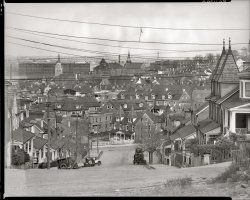
- Crooked House: 1941
- ... Medium format acetate negative by Russell Lee for the Farm Security Administration. View full size.
Service Satisfied Is ... Posted by Dave - 10/24/2022 - 9:54am -
![Crooked House: 1941 April 1941. "House and children in Negro section (South Side) of Chicago, Illinois." Medium format acetate negative by Russell Lee for the Farm Security Administration. View full size.
Service SatisfiedIs painted on the building across the street and reflected in the window. But it did not pertain to this house. That lean no doubt affected the plumbing, gas line, and probably electricity. It must have been a miserable house to be in during a Chicago winter.
I wonder what the temperature was on this April day. The woman in the second-floor apartment has her windows open as if it's warm while the woman on the sidewalk is wearing a long coat. Most of the kids are wearing coats but the girl carrying a book and the boys in shorts at center and far right are dressed as if more layers aren't needed.
82 degreesSometime in April 1941, the temperature reached 82 degrees. I don't think it was this day, but there was obviously an unseasonably warm period during that month.
[It was chilly on the way to school. That afternoon, not so much. - Dave]
A Sign Unto You ... in the window. It's a storefront church.
There's a lien on that houseSaith the process server.
If you tilt your head a little --Actually, the "crooked house" is the one on the left. Its foundation has probably sunk on the side out of view of the camera. If you use the school building on the right for perspective, you'll notice that the subject house is not too bad. Part of the first floor does lean to the right (makes me wonder if the street is on a hill). But the second floor seems altogether straight up.
[Untilt your head! Straight lines in red. - Dave]
(The Gallery, Chicago, Kids, Russell Lee)](https://www.shorpy.com/files/images/SHORPY-8c00842a.thumbnail.jpg)
- The Farmer's Daughter
- October 1938. Farm girl in Seward County, Nebraska. View full size. 35mm nitrate negative by John Vachon for the Farm Security Administration.
I think… …I heard a joke about her once...
... Posted by Dave - 12/11/2007 - 9:38pm -
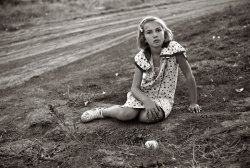
- Spinning a Yarn: 1942
- ... 4x5 inch acetate negative by John Collier for the Farm Security Administration. View full size.
Just a guess She has picked ... Posted by Dave - 10/30/2022 - 1:27pm -
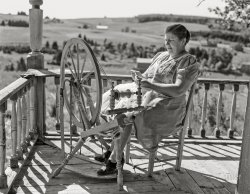
- Ford Fox: 1940
- ... to automobile." 35mm negative by John Vachon for the Farm Security Administration. View full size.
He'll need that coat soon ... Posted by Dave - 05/07/2014 - 1:25pm -
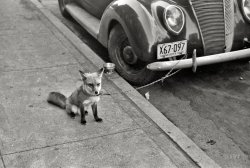
- Tomatotown: 1941
- ... 4x5 inch acetate negative by John Collier for the Farm Security Administration. View full size.
Only standard lights in sight ... Posted by Dave - 09/04/2022 - 5:00pm -
![Tomatotown: 1941 August 1941. "Cambridge, Maryland, home of Phillips Packing Co. tomato canning plant." As well as Phillips Hardware at the corner of Muir and Race streets, and a green-on-top stoplight. 4x5 inch acetate negative by John Collier for the Farm Security Administration. View full size.
Only standard lights in sightI'm surprised the Phillips Hardware building still has its cornice - its neighbor doesn't:
Green on Top?How can you tell from a black-and-white photo?
Never MindSaw it when I enlarged the pic.
The Bros.The same pair of brothers - Levi and Col. Albanus Phillips Sr. - owned the hardware company and the packing company. After the obligatory Massive 1910s Fire in Cambridge's main commercial district destroyed the hardware store and others, the brothers purchased the sites across Race Street that had been occupied by the home of canners W. Grason and Nannie Winterbottom and a lumber yard owned by architect/builder J. Benjamin Brown. Mr. Brown designed many of the buildings that rose from the ashes of his business and others in the fire zone.
From 1910 to 1923, before the property at Race and Muir was sold to the hardware company, it was owned by Mr. and Mrs. Winterbottom, Levi Phillips (and his wife Florence), and Albanus Phillips (and his wife Daisy). All four Phillipses died between April 1945 and January 1949.
The building's most recent use is as a venue for special events.
https://mht.maryland.gov/secure/medusa/PDF/Dorchester/D-380.pdf
Nice variety of pumps... but the "depression brick" siding is an odd pattern I haven't seen before. Hereabouts, we had a good sampling of that stuff around town, along with the asphalt shingle version. When applied well they can be pretty convincing from a distance. It has started to get harder to find as the old buildings get torn down for what the current folks mistake for architecture.
[Especially hard to find in this photo! - Dave]
'tis hard to see here- how'n heck can I get it to move? On the othe hand, if I leave it here I can only make a single mistake, try to correct it and the possibility is endless.
Guess it's your move, Dave.
I'll bet a buckthat sign said Shorpy. Best store in town.
The Phillips Hardware Co. building still looks good. Initials PHC are still in each decorative transom window. Fate has not been so kind to the building on the right. In an effort to make it look modern, an owner stripped away or covered up architectural detail and replaced the large upper story windows with much smaller windows that cannot be opened. I guess they don't want natural light or fresh air up there.
High Green?I wonder if the green-on-top signal is a carryover from the railroad signals of the day? "High green" was called out between the engineer and fireman when approaching a clear (or go) signal. This in itself may have carried over from the semaphore type signals when the arm "dropped" down to show a red signal and the arm or blade was horizontal.
[It's green on top only on Muir Street. On Race Street, it's red on top -- the signal has just three bulbs for all 12 lenses. To get red on top for both streets you'd need a more expensive 12-bulb signal. - Dave]
Red=stop, green=go, yellow=confusionFollowing up on Dave's explanation, it's easy enough to see how it worked for red and green, but what about the middle light?? Without some kind of rotating baffle, it would show yellow for both directions: "proceed with caution" in theory, but surely accidents waiting to happen in practice.
[Back in the day, stoplights often showed yellow (simultaneous with red) when changing from red to green. This would be one of them. - Dave]
OK, both yellow and the red/green would be illuminated simultaneously, so you would know- hopefully! - if your yellow meant turning to red or turning from it; still rather confusing ... I think they would have been better off with only the two colors.
Start of the Phillips empireThis is the same Phillips family that went into the seafood business and eventually opened Phillips restaurants and airport locations present today. Also, you may find their products in the frozen foods section of your local supermarket.
(The Gallery, John Collier, Small Towns, Stores & Markets)](https://www.shorpy.com/files/images/SHORPY-8c25766a.thumbnail.jpg)
- Drink Dr. Pepper: 1939
- ... Double Cola. 35mm nitrate negative by Russell Lee for the Farm Security Administration. View full size.
Hey, there's Shinola! ... Posted by Dave - 05/17/2014 - 11:47pm -
![Drink Dr. Pepper: 1939 November 1939. Waco, Texas. "Proprietor of small store in market square." Pop bottles on the cooler: Woosies, Double Line and Double Cola. 35mm nitrate negative by Russell Lee for the Farm Security Administration. View full size.
Hey, there's Shinola!Left hand side, third shelf down. I remember the old saying, "He doesn't know ---- from Shinola." Well, this man apparently does.
@michaeljunkbox - Try Amazon. You may be able to get Baby Ruth bars.
Slight Name ChangeThe dot in Dr. was removed in the 1950's so as to not have any connection with the medical profession.
[That's an urban legend. At the end of this article at snopes.com it's explained that the period was dropped as a result of a typographical change to the logo in 1950. - tterrace]
Yes-we have no bananas.
(I know it's lame, but that was the first thing that popped into my head when I saw the photo!)
Baby Ruth!My favourite chocolate bar - we can't get them here in Canada - must travel to the U.S. of A.
Soda song"Dr. Pepper is the friendly pepper upper, Dr. Pepper never ever lets you down." From memory and someone will check that on Google and correct or add a line.
Thanks, Tterrace.
[If you follow the bouncing ball, there's a couple extra "nevers" in there. - tterrace]
Now, where in tarnation Pop the Prop is trying to find room for the "Lotto Sold Here" sign. Also, might be a good time to consider deploying some flypaper. Judging by the mature look of those bananas, he might want to think about slashing their price a few cents. The grapes have been around a bit, too, it appears. Kind of a reminder of how we tend to take such things as fresh fruit for granted.
Bananas, 15 cents a dozen.What a bargain. I remember buying bananas, circa 1964, 15 cents per pound or 3 bananas. That 15 cents, in 1939, got you 4 whole pounds of bananas!
What are they?What are those things in the oval packages under and a bit to the left of the light bulb? It looks like the word is Slipxx? At first, I thought they were Easter chocolates.
["Slipknot Soles." - tterrace]
Sales appealI wonder if that was the regular price for bananas or the "reduced for quick sale" price. They look like they're ready to be baked into banana-nut bread!
Baby Ruth!Canadians have their own version: the Oh Henry! bar. There's much discussion over whether one or the other creators of these products stole the idea from the other. In the meantime, if you get really desperate for your Baby Ruth fix, drop me an email and I can airmail you a survival package.
Old solesThey are indeed Slipknot Soles; shoe attachments to keep you OFF the floor and ON your feet. They also help keep you from hearing your friends utter those dreaded words: "Did you have a nice 'trip'?" and "See you next 'fall'!"
Look out, Baby Ruth!Are those cigars being sold in amongst the "candy" at 3 for 5 cents? Perhaps they're chocolate cigars.
Biggest SellerI bet he sold more candy, soda and smokes than he did fruit. The forbidden is much more alluring.
Dr. Pepper sold hereand guess where it started out.
Thanks for Slipknot infoI just couldn't figure out all of the letters. Baby Ruths are still around in the US, as are Oh Henry! bars. It's the Skybars that are hard to find.
Waco, home of Dr PepperAnd home of the Dr Pepper museum....
No period in "Dr" (for only the last few decades): the favorite typo to loose points for in the Baylor journalism school. (Guess who sponsors the footbll team?)
[How did you do at Baylor? - tterrace]
Rather well...
(The Gallery, Russell Lee, Stores & Markets)](https://www.shorpy.com/files/images/SHORPY_8a27552a.thumbnail.jpg)
- Slum Kids: 1940
- ... the slums." 35mm nitrate negative by John Vachon for the Farm Security Administration. View full size.
Dumbstruck I made the dumb ... Posted by Dave - 09/01/2010 - 3:04am -
![Slum Kids: 1940 April 1940. Dubuque, Iowa. "Children who live in the slums." 35mm nitrate negative by John Vachon for the Farm Security Administration. View full size.
DumbstruckI made the dumb mistake of looking at it full view. What a haunting photo.
Learn something new every dayI didn't know that little Sandy Duncan grew up in Dubuque.
What are they doing now?They do look a bit sad ... I wonder what they did of their lives, and what they are up to now. They must be about 65 years old now.
[They'd be at least 75. - Dave]
Haunting meFor some reason their face expressions haunt me after studying them for about 20 or more minutes. I am approaching 70 years on this planet now and even after all those years my heart can and does go out to them. My hope is that first comment "Entitlement- - " came true for them. They look like they deserve it.
Poor kidsNice patch job on the boy's pants. Even though they are quite young they understand the meaning of poverty. It is etched upon their faces.
Tugs at the HeartSomething about this photo makes me want to grab and hug them, and tell them everything is going to be alright.
HeartbreakingI don't have any other words. This picture really affected me. There is no excuse for the suffering of children. The clothes, the girl's eye, the dirt. I wonder what became of these kids. What life did they lead.
EyesThe girl has "lazy eye"? Easily corrected in the young, but not in adults, according to the Net.
Doh!I love Shorpy and view it every day in the hope and anticipation that I'll get to see some old school photos of my lovely home town. Maybe of the tragically destroyed Union Park, or our historic and recently renovated Shot Tower, or even the downtown bustling with shoppers and beautiful architecture. Oh well, I guess I'll have to make due with a couple of sad slum kids. :D
Growing up poorWhen you grow up poor, there is nothing anyone can do to you that life itself hasn't already done. Trust me.
HeartacheAren't they precious? I want to scoop them up and hug them. Oh, how I hope they went on to have long, happy, bountiful lives.
Inspiration They look like the inspiration for those "Sad-Eyed Kids" paintings.
The thing about kidsis that unless someone TELLS them they are deprived and that their lives are terrible, they often don't live their lives that way.
I'm not trying to romanticize the life of the poor but as long as they are loved and can play and enjoy their friends, they are usually perfectly happy. The minute they are treated as "different," that other people should look down on them, that they aren't equal to their friends, that's when they learn to hate themselves.
No entitlement mentality here!They were born in the mid-30's and are poor here, but they will be part of the small generation of young adults in the mid-1950's and enjoy America's great Postwar economic boom. They'll get a good education in the schools of the day, most likely better than those of today, and be able to get employment for life. Life after World War II will just get better and better for them and compensate for their poverty as children. They're in their 70's now and I hope comfortably retired with lots of grandchildren and great-grandchildren who love them.
John VachonI had never known about Vachon's photographs until seeing them on Shorpy, but I am starting to believe he's one of the great photographers of his generation. It's incredible that he had no art, design or photography training before starting with the FSA as a filing clerk and messenger. It's easy to see why Roy Stryker said Vachon was the FSA's "congenital photographer." He had amazing and innate talent and artistic insight, as this image clearly shows.
[He also took a bazillion pictures. Quite a few of this pair, shown below in happier times. Like 30 seconds later. - Dave]
What happened to them? Victrolajazz is right about the opportunities these kids had as they got older. For better or worse, however, their early upbringing was probably never forgotten. My aunt, slightly older than these two, carried the memories of poverty in the Depression all of her life. Even as a well-to-do senior citizen she would always buy the winter coat that cost less, no matter what she preferred. I sometimes think that that feeling of "the wolf at the door" was a better one for our country.
Depression BabiesA friend and I were born in 1930. He thinks the 1930s were the best time for this country. As I recall the decade, life was good for those who had jobs. The father of a boyhood friend was a handyman at the streetcar hq. Over time he made enough to buy a new house and a new car. He took the family every summer on a long trip. His wife did not work. They were frugal. They went to church about three times per week. The church actually was just a basement, the rest unfinished. The 1930s featured a lot of unfinished buildings. Scientific studies show that church is good for people in many ways.
Geez, what's wrong with a little dirt?They've already proven that letting kids get dirty gives them a little resistance to things like polio and asthma.
Except for the lazy eye, I could have sat right next to those kids at that age and fit into the pictures. Those kids ran and jumped and played all day. They did not sit in a room holding a little box staring at it all day. They caught bugs, made swords and knives with sticks and the little boy probably dropped a frog down his sister's back a time or two.
I feel sorrier for kids today than I do for these beautifully shaped kids.
It's not that her left eye is lazy,It's that her right eye is an overachiever!
John VachonJohn Vachon was, in my opinion, the best of all the FSA photographers. His pictures lack the sometimes self-conscious drama of Dorothea Lange. They are plain, less artful, and often concentrate on the landscapes of towns and cities, instead of people. For that reason, his work is perhaps the most valuable collection we have of what the uncelebrated and unnoticed parts of America looked like during this era.
OK, Dave, now you've done itAfter looking at hundreds of Depression era photos here and elsewhere, I thought I had seen the most poignant, precious faces there could be. But when you posted the smiling photo below, these little beauties took on a dimension far beyond what two photos should be able to create. Despite their obvious poverty, they radiate in their innocence a joy that I desperately hope they were able to find again for keeps, as they went through life.
BeautifulSuch a beauty in such a cruel world. A thank you to the person who posted the second picture. That smile is so familiar. Timeless.
(The Gallery, John Vachon, Kids)](https://www.shorpy.com/files/images/8a05450a.thumbnail.jpg)
- Cajun Spice Girls: 1938
- ... Louisiana." 35mm nitrate negative by Russell Lee for the Farm Security Administration. View full size.
Trend setters This was the ... Posted by Dave - 03/22/2012 - 12:32am -
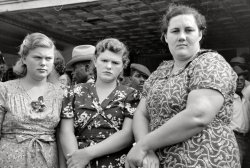
- Cherokee Parts: 1936
- ... Large-format nitrate negative by Walker Evans for the Farm Security Administration. View full size.
Modern Day Wheel The wheel ... Posted by Dave - 07/22/2012 - 2:43pm -
![Cherokee Parts: 1936 March 1936. "Auto parts shop. Atlanta, Georgia." Large-format nitrate negative by Walker Evans for the Farm Security Administration. View full size.
Modern Day WheelThe wheel directly below the "A" and "R" of "garage" looks like it could easily be used on one of today's cars.
Sure Beat UpThis truck appears to be a 1928-29 Ford cobbled out of something else. The rear of the cab isn't from a stock pickup. Really beat up for a vehicle 7-8 years old. And those Model A's were built like a tank. It's had a rough life.
InvitingOh, imagine opening the place up and starting work by hanging all those car parts up. And then imagine the passing punters: "that looks nice, especially that fender there - I think I'll have them do my car right away!".
Mystery MetalI can't for the life of me figure out where that large apparent body part hanging under the word "Used" would go on a car. Anyone know?
[Front right fender. - Dave]
Ah, OK, we're seeing it from the top, then, and it's a lot deeper than it looks here. Thanks.
Greatest HitsThis photo was the inspiration for the cover art on the album "Alice Cooper's Greatest Hits."
Whoa!, that font!Is it just me or does that beautiful lettering scream Jazz Age!! ?
From cars to packing machinesCherokee Parts Store was at 973 Marietta Street in Atlanta. That location is now home to a packing machine company.
View Larger Map
re: Greatest HitsInteresting - apparently, Drew Struzan drew the "Greatest Hits" artwork with the band surrounded by iconic stars. The original included 13 stars who were still alive, which presented a problem, so they had to re-do it without those individuals. A related piece doesn't really resemble the garage in Evans' photograph, but does include the name:
Quite the place back in the dayIt seems that this place was a real chick magnet at the time.
Re Modern day wheelIn fact, my eyes double-took when I saw that wheel, which is not too different from the ones on my E-Class MB. And, boy, they did have a lot of merchandise to hang outside while their morning coffees were cooling, didn't they?
Is that you, Jack?Probably not, but the young guy inside the garage sure looks like a young Kerouac. 'Course Kerouac lived in Massachusetts then. The young lady on the far left seems to have noticed something--maybe the guy--in spite of her disgust at having to be there at that smelly old garage while her mother gets new tires.
'29 Ford roadster pickupThat's a 1928 or '29 Ford Model A roadster pickup, looking mostly original except for the wheels and the absence of its top, doors and spare tire. The fabric top was removable, but not foldable, and the car had no side windows, only side curtains that clipped onto the doors and windshield.
Font NameTo JeffK: although the sign appears to be hand painted, the font that inspired the lettering is "Windsor." The sign painter did not copy the typeface with 100 per cent accuracy, but after 40 years in the graphic design business, I'd say Windsor!
Just down the streetThis is just down the street where my dad (a mechanic) grew up. He probably visited the shop many times.
AirwheelsThat Model A is wearing a pair of aftermarket low-pressure tires on the rear, also known as Jumbos, the tire and rim combination were offered by several tire companies and claimed improved ride and handling over the narrower high-pressure stock units.
Those wheels are rarely seen on restored vehicles today because those special sizes haven't been reproduced, modern tires will fit on them so they do see some use by traditional hot-rod builders.
Wheels,etc.The large part hanging under the used sign is a fender as mentioned in an earlier post. It is from a 1930/31 Ford.
I would love to see under the hood. I would bet money it has a Flathead V8 in it. The front wheels are off of a 32 or later which means they have probably changed from mechanical brakes to hydraulic and the rear wheels look the GM "Artillery" wheels used on later 30's GM cars. The wheel hanging on the wall behind the woman is a stock 29/31 model A wheel. I think this may be the shops hot rod parts truck.
NASCAR ConnectionAbout 13 years after this picture was taken, Cherokee Auto Parts began sponsoring Gober Sosebee in the earliest years of NASCAR. Both his #50 and #51 cars carried the name on their doors. He had 2 wins, 4 poles, and 33 top tens in a 71 race career.
(The Gallery, Atlanta, Cars, Trucks, Buses, Walker Evans)](https://www.shorpy.com/files/images/SHORPY_8c52233u.thumbnail.jpg)
- School Shooters: 1942
- January 1942. "Cowboys and Indians" at the Farm Security Administration camp elementary school in Weslaco, Tex. View full ... Posted by Dave - 12/16/2007 - 10:12pm -
![School Shooters: 1942 January 1942. "Cowboys and Indians" at the Farm Security Administration camp elementary school in Weslaco, Tex. View full size. Photo by Arthur Rothstein.
Cowboys & IndiansTry that now and they'd be in jail and the school would be in lockdown!
[Let's not forget the mandatory cultural-sensitivity training. - Dave]
Weslaco, TexasI live about 20 miles from Weslaco. It made me smile to see a little bit of history from my own backyard. Hope to see more of this area soon!
SchoolkidsWish it was still this innocent ...
SidesCan't figure out which are the cowboys and which are the Indians.
Times ChangeKids playing with toy guns at a school run by the FEDERAL Farm SECURITY Administration !
Did Pres. Roosevelt know about that??
That photo is priceless!
School ShootersLet's not worry about kids playing with toy guns. Worry about a sulking, unhappy, rejected young person with access to real guns and ammo.
Yikes!Cowboys oppressing Native Americans? PLAYING with toy firearms? Gasp! Just think of how poisoned the minds were of these children!!! Nowadays, we keep them safely inside on the couch munching potato chips, playing video games, and getting fat & lazy.
WeslacoThis is my hometown, which i currently reside in. I wonder what now stands at the site of the school
(The Gallery, Arthur Rothstein, Kids)](https://www.shorpy.com/files/images/8a13425u_0.thumbnail.jpg)
- Ideal Rest: 1941
- ... Medium format acetate negative by John Collier for the Farm Security Administration. View full size.
The route of colourful meals ... Posted by Dave - 09/30/2022 - 12:11pm -
![Ideal Rest: 1941 October 1941. "Little Falls, New York (vicinity). Truckers' service station." Medium format acetate negative by John Collier for the Farm Security Administration. View full size.
The route of colourful mealsYou might remember we were only offered a "regular" dinner in Syracuse, so things are looking up !!
Wonder what the choices will be in Albany.
Above Ground tank?I sure hope nobody ever drove into that tank! I've never seen fuel stored like that... Looks dangerous!
Call for Philip MorrisLast seen on U.S. Highway 80 in Texas, now Johnny the Bellboy is looking for Philip Morris in upstate New York!
Whatta swell rest!Must have been the liberal use of essential oils that helped me have an ideal rest!
Ideal Rest No. IThe round Ideal Rest sign at the pumps identifies this as station No. 1. I hope we'll eventually see the rest of their truck stops. I wonder if each had an "oils" shop, with a window display that looks like scented candles. Today, gift shops in truck stops are a closely watched profit center.
This is a Richfield gas station with a sign on the utility pole stating Richfield credit cards honored here. In 1966 the Richfield Oil Corporation merged with Atlantic Refining Company to form what is today known as ARCO.
Owner of the "Ideal Rest" in PeaceAnton Christensen died April 30, 1956, in East Creek, N.Y., aged 74. From his obituary:
Anton Marinus Christensen was born in Judtzland, Denmark [in 1881] and came to this country in 1914. He settled in Little Falls, where he ran farms until he opened the "Ideal Rest".
In 1944 he purchased the Beardslee Mansion at East Creek, and conducted it thereafter as the "Manor". He was forced by illness to retire about a year ago, and since then, a daughter, Mrs. Clarence (Kaya) Kimball, has been the manager.
Survivors are his wife [Marion K. Olsen Christensen], three sons, John of Chittenango, Sven of St. Johnsville and James of Rome; four other daughters, Mrs. Arthur West of Rome, Mrs. Harvey (Constance) Burdick of Vernon, Mrs. Joseph Jaworski of St. Johnsville and Mrs. Richard (Maude) Borst of Portland, Ore. Also 18 grandchildren and two great-grandchildren.
Need a bigger sign because "aurant" wouldn't fit on the one on the rooftop.
(The Gallery, Cars, Trucks, Buses, Gas Stations, John Collier, Small Towns)](https://www.shorpy.com/files/images/SHORPY-8c26160a.thumbnail.jpg)
- Meet the Labbes: 1940
- ... Medium format acetate negative by Jack Delano for the Farm Security Administration. View full size.
Handrails are for wimps If ... Posted by Dave - 10/02/2021 - 11:10am -
![Meet the Labbes: 1940 October 1940. "Mr. and Mrs. Lindore Labbe and children in their newly-built home. Mr. Labbe, FSA client, runs a small seed foundation unit in Wallagrass, Maine." Medium format acetate negative by Jack Delano for the Farm Security Administration. View full size.
Handrails are for wimpsIf you fall, you might get lucky and land in the comfy chair.
More to the storyAccording to geni.com, the name was spelled LABBÉ, with an accent aigu. Mrs. Labbê's name was Myrtle, and the daughters were Gail and Jacqueline. Lindore was born in 1902, and lived until 1987. Myrtle was born in 1901, and died in 1972. That house may have been new, but it looks almost absurdly underbuilt to withstand - let alone provide comfort - in Maine winters.
[Their grave marker, sans accent, gives 1901 as the birth year for both. - Dave]
Settled in for the evening, they are.Let's see what's on the coal stove tonight. Oh, a finial -- not again.
NASCAR tie inIn NASCAR there is a full time Canadian driver in the Xfinity series named Alex Labbé. There also is a Mainer from Saco who is a former crew chief and now consultant named Slugger Labbe.
La-bay and Lab-bee.
LL Bean Maine Hunting ShoesMr. Labbe has on a pair of what is now known as Bean Boots but at least into the 1990s these were Maine Hunting shoes. I have a pair from 1990. LL Bean offers a resoling as needed.
Say Cheese!The youngster in the white shirt seems particularly enthralled with the photographers assistant (with hand visible) standing behind the brick chimney firing the flash.
Accent aigu (and grave)There's a longstanding debate over whether capital letters in French should be accented. The Académie Française has apparently decided yes, but it seems that the worker who carved the gravestone didn't get the memo. By the way, "Labbé" could well have been "L'abbé" originally, meaning "the abbot", but apostrophes in French surnames often get lost along the way.
BOO !!!Apparently, a Halloween monster is preparing to scare those youngsters as he climbs out of the wall!
Way Ahead of His TimeNot only did Mr. Labbe anticipate television replacing the stove as center of attention, he anticipated the remote control.
Thoughts on the roomI'm surprised no one has mentioned those STAIRS yet!
Cobbled together from left-over bits of T&G flooring (otherwise visible where the lino stops), with no riser covers and treads too shallow for the steps. At least the visible stringer appears to be well laid out and cut.
And what about the vast amount of paper covering the walls and ceiling? Photo shoot setup, to provide better reflected lighting and to hide unfinished walls?
[It's how people of limited means covered their framing. Lots of photos in the archive like this. - Dave]
AccentsIn France, adding an accent on a capital letter is uncommon. In Québec, we do. So, in France: LABBE. In Québec: LABBÉ (or LABBÉE).
I'm amazedat the amount of French-Canadians who infiltrated Maine, another fact from Shorpy to us in Canadaland.
Construction paperLooks like some of that paper is load-bearing.
(The Gallery, Agriculture, Jack Delano, Kids)](https://www.shorpy.com/files/images/SHORPY-8c03631a.thumbnail.jpg)
- Arizona Motel: 1942
- ... Neon Noir. Medium format negative by Russell Lee for the Farm Security Administration. View full size.
Business trip ... Or family ... Posted by Dave - 05/11/2022 - 4:09pm -
![Arizona Motel: 1942 February 1942. "Tourist court. Phoenix, Arizona." An early example of Desert Neon Noir. Medium format negative by Russell Lee for the Farm Security Administration. View full size.
Business trip ...Or family vacation? Whatever it is, the photograph is great! But what's puzzling me is the scrotum hanging on the crossbar to the right of the sign.
Going out on a limbI am loath to reveal such ignorance but where better to be set straight than here? WHAT is that disc-shaped (or spherical) thing hanging to the right of the neon sign? It appears to be inside (or outlined by) a cage-like (for lack of a better term) structure made of woven rope. Is it a nest or hive? It looks vaguely snakelike. And those are all the clues I'm going to give you.
[It is the counterweight on a neonized version of an old-school well sweep. - Dave]
Once again y'all do not disappoint. I would never in a million years have got that lid off on my own but would you have got it off if I hadn't loosened it for you? Just saying. I mean, just kidding.
Beautiful signI love the little detail of the 2 short neon tubes on the bottom of the sign that light up the AAA panel.
Sign of a weighty matterThat big suspended ball to the right of the motel sign appears to be a counterweight holding the sign up. Why all that to hold a sign up? Perhaps it was to apply a traditonal abobe-style way of holding a sign up, in keeping with style of the motel. If in fact that sign setup is in keeping with the adobe motif.
Balancing Act?I'm betting that's a natural rock or poured concrete round boulder carefully tied and used as a counterweight for the motel sign. Pretty clever and a good use of resources.
Look out below!A counterweight to that neon sign, hung from a dead tree branch.
I would advise you not to stand (or park your car) underneath it.
Introducing the 1941 MercuryHere’s an original dealer training film that details the features of the all-new Mercury line for 1941.
https://www.youtube.com/watch?v=05cUGrerGKs
Non-noir versionLet the sunshine in!
Still there -- sort ofIt's been remodeled and is now transitional housing. Better than being razed to the ground like so many other things in Phoenix.
Nice NeonSuch an evocative photo! If only it could have been in color.
"Air Cooled"So is "Air Cooled" could mean airconditioning, a swamp cooler, or even a fan. I wonder which it was?
I'm impressedit lasted long enough to be remodeled and remodeling was chosen over demolition. The remodeling is fairly recent; attached is a combined Google Maps photo showing before remodeling and Google Earth photo showing during. It looked to be in pretty bad shape.
Click to embiggen.
Lit UpIn response to those desiring a colorized look, at the neon sign, my feeble attempt.
Glowing PraiseI really like the neon Shorpy!
Lone Snag MotelSeen here some 17 years later (both visible cars are 1959 vintage), the sign and counterweight are gone, but the dead tree still stands.
(The Gallery, Cars, Trucks, Buses, Russell Lee)](https://www.shorpy.com/files/images/SHORPY-8c23999a.thumbnail.jpg)
- Eggs Kerosene: 1939
- ... format acetate negative by Marion Post Wolcott for the Farm Security Administration. View full size.
Savannah Confirmed See the ... Posted by Dave - 09/15/2022 - 11:16am -
![Eggs Kerosene: 1939 June 1939. Savannah, Georgia. "Negro grocery store." Last seen here. Medium format acetate negative by Marion Post Wolcott for the Farm Security Administration. View full size.
Savannah ConfirmedSee the sign for the circus in the upper right hand corner.
The Magnolia sideThis pic further supports the Savannah (vs. Sylvania) premise, since the distant undercrossing (to the Savannah Union station) matches the Sanborn map. Will we move down the street to 737 and 735 Magnolia and find out what they were ???
What's in a title?This one could have easily been called Fish Lard.
Amazing PricesPoor people stuck to the basics in those days. Today that location is underneath a freeway.
Turn the cornerThank you, Marion Post Wolcott, for showing us the other side. I’ll have a pound of fish for a nickel and a pound of short ribs for a dime, please, Oh, and what’s white meat? (I know, I can look it up, and I did, but it’s so vague.)
The BikeThe most amazing thing is that it appears the bike is not chained to the pole. Nowadays, an unchained bike would have been stolen before the owner even made it to the front door.
Not For SaleOf all the items in that store, I would love to have the bike!
A nice cuppaTetley Tea is a very English product so a bit surprised to see it advertised so far from home so long ago.
[The coffee they sold also came from faraway lands. - Dave]
(The Gallery, Bicycles, Gas Stations, M.P. Wolcott, Savannah, Stores & Markets)](https://www.shorpy.com/files/images/SHORPY-8c10389a.thumbnail.jpg)
- Tombstone: 1940
- ... many tourists." Acetate negative by Russell Lee for the Farm Security Administration. View full size.
Only "near" ghost ... Posted by Dave - 10/07/2022 - 11:34am -
![Tombstone: 1940 May 1940. "Shells of old buildings on the main street of Tombstone, Arizona. The near ghost town quality, as well as the reminders of more glamorous and exciting days, attract many tourists." Acetate negative by Russell Lee for the Farm Security Administration. View full size.
Only "near" ghost town quality?Those Tombstonians have always been slackers. They could have been a Yuma!
The rotting remains Russell Lee photographed are long gone. Here's a good shot of the mountains that match what you can see in his photo. If you grab your partner and swing to your left, you can promenade through the rest of the town and watch a gunfight reenactment. It's good clean entertainment.
Popular AttractionBoot Hill: Everyone was just dying to get in.
Lead poisoningfrom all that crumbling paint is likely what many see when viewing a pictue like this, tho of course the town was known for "lead poisoning" of a different sort.
Brings to mind a grabber real estate blurbPotemkin village with retro charm, wide-open creative potential!
They turned the town into a tourist trapSome forward thinking people made firewood out of those old buildings and rebuilt the main street into shops and attractions that would be familiar to any tourist of the desert Southwest. In addition to the new stuff there still exists the OK Corral (famous gunfight in 1881), the opera house, the old Western newspaper (Tombstone Epitaph), Fly's photography shop and Boot Hill.
I haven't been down there in years but they also used to have "the world's oldest/largest rose bush". I saw it back in the 1950s and it was indeed huge!
[The old City Hall has an interesting exhibit of antique barbed wire. But really, keep driving until you get to Bisbee. - Dave]
Not very energy efficient I'd be inclined to focus on insulation...like lots of it. Spring can still be cold in Tombstone. And maybe adding double pane windows. I'm also thinking maybe a roof, but that's just eye candy and could be added later. I'm not sayin' any of this is necessary, but it's what I would do.
(The Gallery, Frontier Life, Russell Lee)](https://www.shorpy.com/files/images/SHORPY-8b24969a.thumbnail.jpg)
- Mrs. Piggy: 1940
- 1940. "Curtis Whitlock, Sanpete County, Utah, Farm Security Administration rehabilitation client, was on Work Projects Administration ... Posted by Dave - 08/02/2012 - 8:19am -
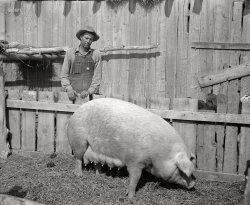
- Chicken Dinner: 1942
- ... a chicken." Acetate negative by John Vachon for the Farm Security Administration. View full size.
Big crowd on the way Looks ... Posted by Dave - 02/12/2022 - 2:55pm -
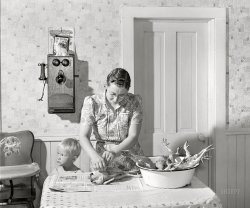
- Try the Train: 1937
- ... Medium format nitrate negative by Dorothea Lange for the Farm Security Administration.
Magnificent Now THAT is a photograph. Such ... Posted by Dave - 07/17/2012 - 10:12pm -
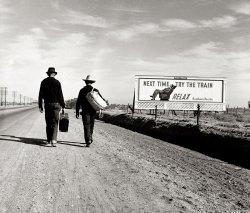
- No-Nox: 1941
- ... Medium format acetate negative by John Collier for the Farm Security Administration. View full size.
They go for you John ... Posted by Dave - 10/02/2022 - 4:17pm -
![No-Nox: 1941 October 1941. "Defense motive in advertising. Elmira, New York." Medium format acetate negative by John Collier for the Farm Security Administration. View full size.
They go for youJohn Collier was either lucky or patient enough for this shot to have the lampshade shade perfectly covering the 'o'. Gulf was being a little sexist here, unless the two men are looking at each other. Gulfpride.
[That's the lamp's shadow covering the O. - Dave]
Shadow! That's the word I wanted! I was having a brain fart and the only word I could think of was shade. Thanks Dave, I don't mind my place in your shadow.
No engine knocking?Did Gulf gasoline have healthy extra tetraethyl lead to boost its octane rating?
I don't think they cared about nitrogen oxide emissions then.
Catalytic converters? Never heard of them.
Baby GasThat Texaco sign is using a baby for some reason. Can't quite tell, but it looks like a "Guest Room"? Or is it "Rest Room"?
Pre-WarEven though the US did not become a direct combatant in World War II until December 1941, it is obvious from much of the advertising and other signs of the mass media in 1940 and pre-December 1941 (radio, movies, newspapers) that there was every expectation that it would eventually come to pass. The Lend-Lease program was in full swing, and the American manufacturing base was already tentatively starting to transform itself into the greatest war production machine ever. We were still caught a bit flat-footed on December 7, 1941, but it wasn't exactly a shocker either.
Hot cornerGulf, Esso, and Texaco all vying for brand loyalty.
Slow down or else!I would bet that there's a motorcycle cop hiding behind that Gulf billboard waiting for the next speeder.
(The Gallery, Cars, Trucks, Buses, Gas Stations, John Collier, Small Towns, WW2)](https://www.shorpy.com/files/images/SHORPY-8c26170a.thumbnail.jpg)
- I Saw What You Did: 1939
- ... depot." Acetate negative by Marion Post Wolcott for the Farm Security Administration. View full size.
Alternate Title I Dado What ... Posted by Dave - 09/17/2022 - 1:11pm -
![I Saw What You Did: 1939 May-June 1939. Atlanta, Georgia. "Woodworking shop at FSA warehouse depot." Acetate negative by Marion Post Wolcott for the Farm Security Administration. View full size.
Alternate TitleI Dado What You Sawed --
I was hammeredIt's my worst vise.
I needed to drill my way out of this joint and board a plane. But first I tapped my mudder for some scratch. It wasn't easy, she's tough as nails. But I told her I was on the level.
Drill Sergeant"Did you hear about the blind man who picked up a hammer and saw?"
I Wood Do ThatI would be glued to my work everyday. Then I wood go home to my wife Mortice and kiss her and the kids, Dowel, Rod and my little girl Eucalyptus. I Pine for them everyday.
I'm curious ...What do you use a fire ax for in a woodworking shop?
[Fires. - Dave]
I could work thereThis looks like a great space to work, lots of natural light, room to move around and in Atlanta it would still be comfortable in the winter months.
Plywood tableSame pattern I use, made a hundred of them probably. Two sheets of 3/4 yields an 8x4x3 table.
(The Gallery, Atlanta, M.P. Wolcott)](https://www.shorpy.com/files/images/SHORPY-8c10360a.thumbnail.jpg)
- Icing on the Coke: 1938
- ... general store of the Lake Dick cooperation association, a Farm Security Administration project near Altheimer, Arkansas." Medium format ... Posted by Dave - 03/09/2018 - 4:00pm -
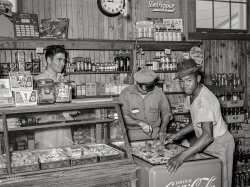
- First-Nighters: 1941
- ... Whitney and wife in a restaurant." Photo by John Collier, Farm Security Administration. View full size.
Mmmm Fig bars and ketchup. ... Posted by Dave - 09/11/2022 - 6:14pm -
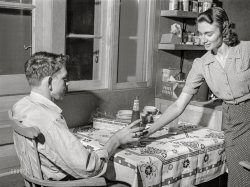
- Movie Night: 1942
- February 1942. "Tulare County, California. FSA farm workers' camp. At the movies." Not to be outdone by our previous FSA ... Medium format acetate negative by Russell Lee for the Farm Security Administration. View full size.
Re: Third Bird I see a ... Posted by Dave - 04/22/2022 - 8:27am -
![Movie Night: 1942 February 1942. "Tulare County, California. FSA farm workers' camp. At the movies." Not to be outdone by our previous FSA photo, we have two birders here, and three birds! Medium format acetate negative by Russell Lee for the Farm Security Administration. View full size.
Re: Third BirdI see a third, about 7 rows from the front, near the left side. And that plaid shirt (behind Double Flipper) has seen better days, for sure!
I ain't touchin' that!Judging by the looks on some of their faces, the film must be the one about STD's.
Two birds, four eyesI see (at least) two people with strabismus in the crowd.
Two "Thumbs" Up!Apparently the young man inn the foreground is doubly displeased with what he's seeing on the big screen.
Long-lived 16mmThat looks very much like the 16mm projector that I used to show movies for my Army company in 1970. (It was a way to avoid guard duty.) They were regular Hollywood films in the 16mm format. This FSA crowd is probably watching something similar.
Portable 16mm sound projectors were popular from the 1930s to the advent of video cassette players. Beyond that, 16mm film was used for the early seasons of 'Sex and the City' and 'Buffy the Vampire Slayer' and for parts of the films 'The Hurt Locker' and Spike Lee's 'Da 5 Bloods' in 2020.
Multiple Avian DisplayThe double bird and the double dog dare were kept in a boy's arsenal only to be deployed when the situation warranted an extreme measure.
GesturesAs a youngster in the 1950s when living overseas, I learned birding the way Flipper and Two-Birds are doing it. When I first got to the States in the very early 1960s is when I learned that American teenagers did it differently. They folded the fingers into the palm of the hand instead of squashing them straight down. Haven't a clue how adults did it since we never associated with them!
Taking a random sample of folks of various ages from teenage to 70+, all seem to have learned and use the folded fingers versus squashed fingers gesture. Wonder when Americans changed from what is shown in the 1940s to what I learned in the early 1960s.
Movin' on up... the Valley: A double-bird ?? Lord, that boy is Folsom Prison bound !!
Kid near the foreground, left of centerEverybody calls him "Red".
Maybe it was a newsreel… and the kid up front is just expressing his opinion of der Fuhrer.
The Third BirdHas no one spotted it?
I think I see the thirdAnd by a girl! She's on the left-center of the photo, with a kind of crazy look in her eyes.
Birds asideWhy are the three kids in the foreground looking at something to our left while all the people behind them are looking off to our right? And why is the kid front and center in the ratty sweater wearing a white glove on one of his hands cupped over his mouth?
[We'll never know! - Dave]
(The Gallery, Agriculture, Kids, Movies, Russell Lee)](https://www.shorpy.com/files/images/SHORPY-8c23889a1.thumbnail.jpg)
- Modern Regent: 1936
- ... Jackson, Ohio." 35mm negative by Theodor Jung for the Farm Security Administration. View full size.
No Smoking! ... please.
... Posted by Dave - 11/17/2011 - 4:41pm -
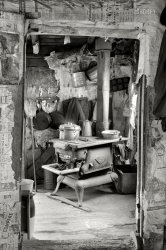
- Dakota: 1940
- ... County." Medium-format negative by John Vachon for the Farm Security Administration. View full size.
Vast, lonely, beautiful. No ... Posted by Dave - 08/14/2012 - 4:59am -
